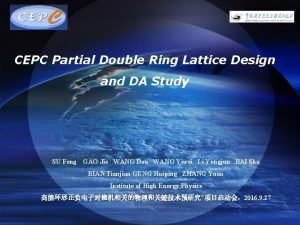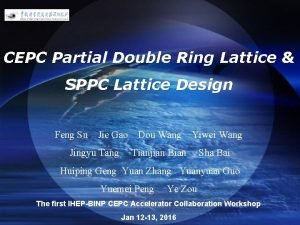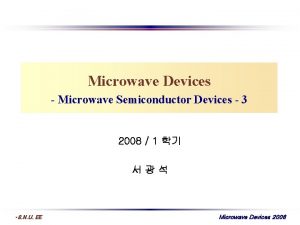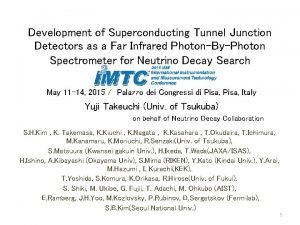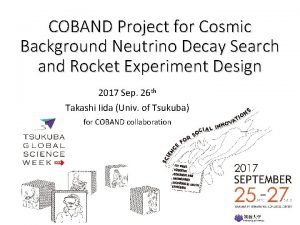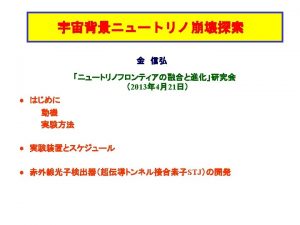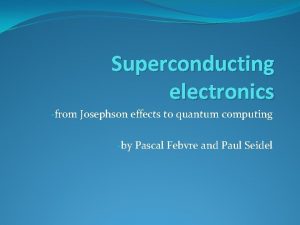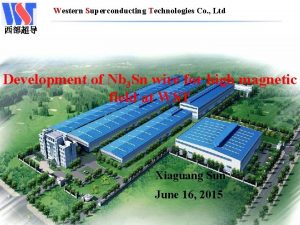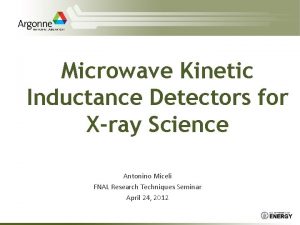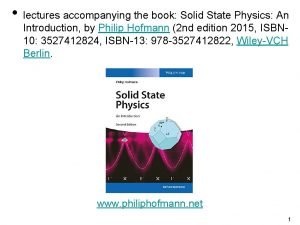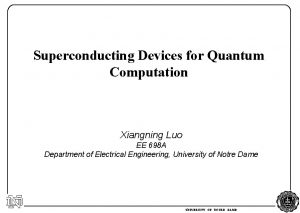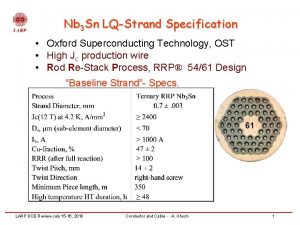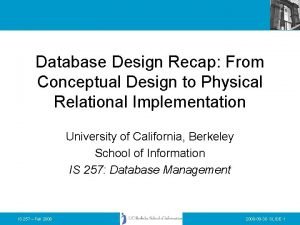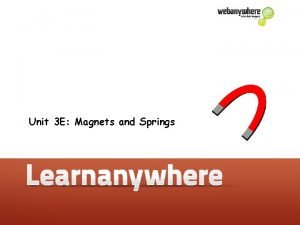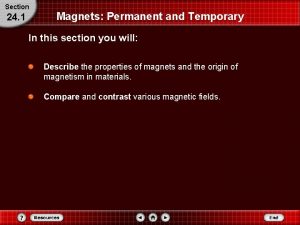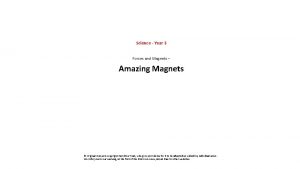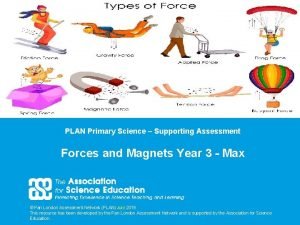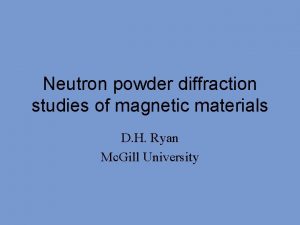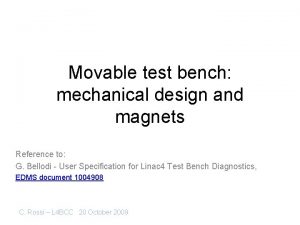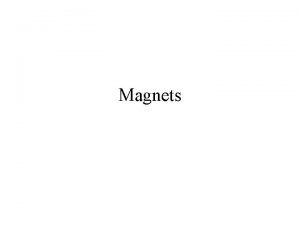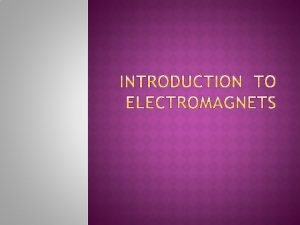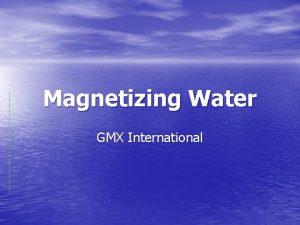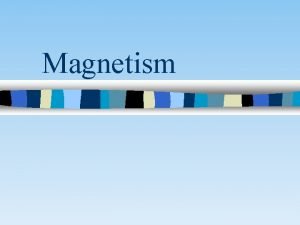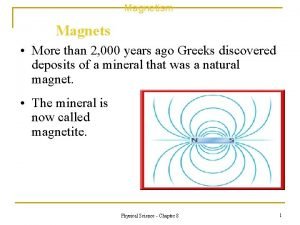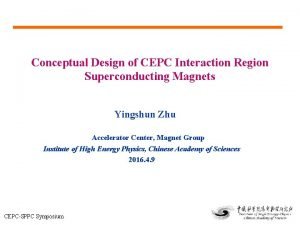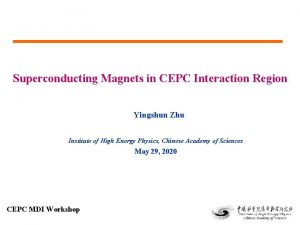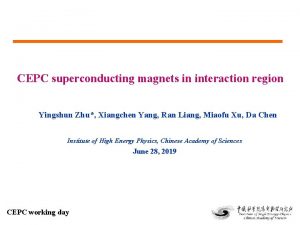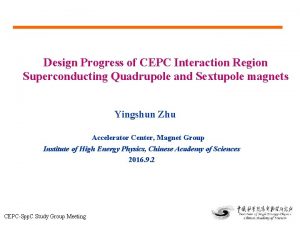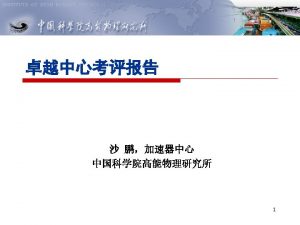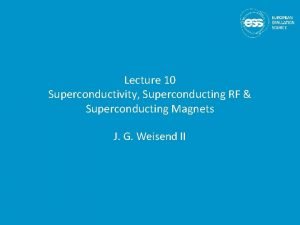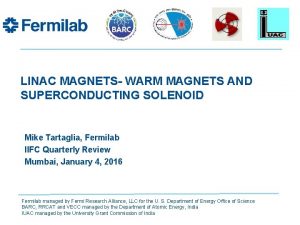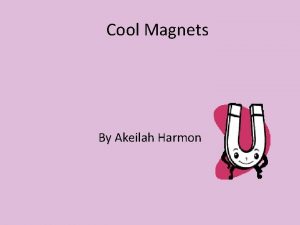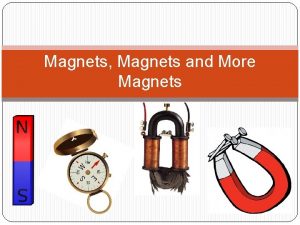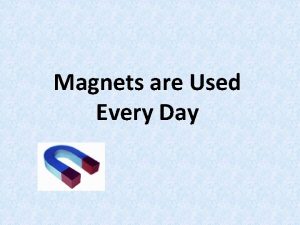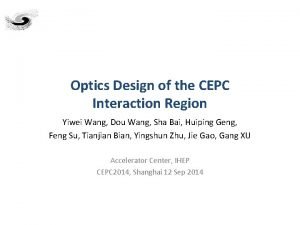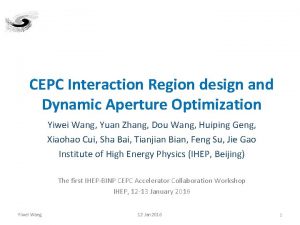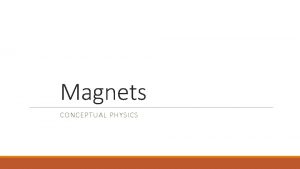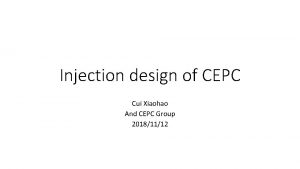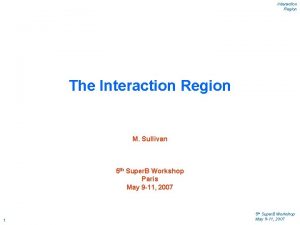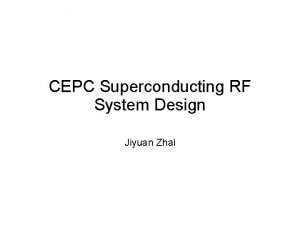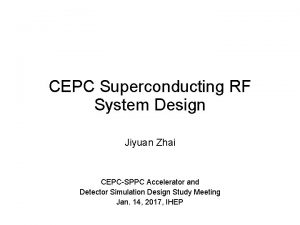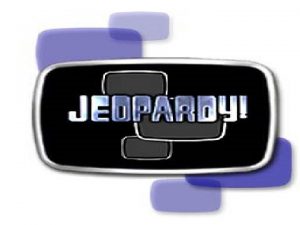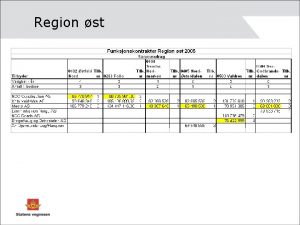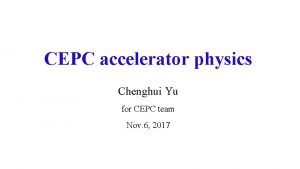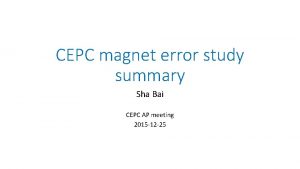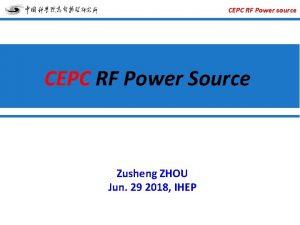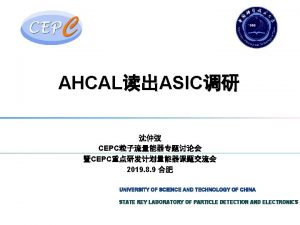Conceptual Design of CEPC Interaction Region Superconducting Magnets




























- Slides: 28

Conceptual Design of CEPC Interaction Region Superconducting Magnets Yingshun Zhu Accelerator Center, Magnet Group Institute of High Energy Physics, Chinese Academy of Sciences 2018. 6. 29

Outline l Introduction l Conceptual design of final focus quadrupole magnets and anti-solenoid l Conceptual design of superconducting sextupole magnets l Summary

Introduction u CEPC is a Circular Electron Positron Collider with a circumference about 100 km, beam energy up to 120 Ge. V proposed by IHEP. u Most magnets needed for CEPC Accelerator are conventional magnets. l Compact high gradient final focus quadrupole magnets are required on both sides of the collision points in interaction region of CEPC collider ring. . CEPC MDI layout Sketch of CEPC Collider ring

u The requirements of the Final Focus quadrupoles (QD 0 and QF 1) are based on the L* of 2. 2 m, beam crossing angle of 33 mrad in the interaction region. Table 1: Requirements of Interaction Region quadrupole magnets for Higgs Magnetic length Width of GFR (mm) (m) Minimal distance between two aperture beam lines (mm) Magnet Central field gradient (T/m) QD 0 136 2. 0 19. 51 72. 61 QF 1 110 1. 48 27. 0 146. 20 u QD 0 and QF 1 magnets are designed to be twin aperture quadrupole magnets. They are operated full inside the field of the Detector solenoid magnet with a central field of 3. 0 T. l To minimize the effect of the longitudinal detector solenoid field on the accelerator beam, anti-solenoids before QD 0, outside QD 0 and QF 1 are needed, so that the total integral longitudinal field generated by the detector solenoid and accelerator anti-solenoid is zero.

u The field distribution of net solenoid field should also meet the requirements from the accelerator beam dynamics. u Furthermore, the MDI layout imposes strict boundary conditions on the longitudinal and transerve dimensions of the accelerator magnets. l Taking into account the high field strength of twin aperture quadrupole magnet, high central field of anti-solenoid, and the limited space, superconducting technology base on Nb. Ti conductor will be used for Interaction Region superconducting quadrupole magnets and anti-solenoids. Ø In addition, there are 32 superconducting sextupole magnets required in the CEPC interaction region.

Conceptual Design of superconducting quadrupole magnet QD 0 u The minimum distance between QD 0 two aperture centerlines is only 72. 61 mm, so very tight radial space is available. u The design of QD 0 is based on two layers cos 2θ quadrupole coil using Rutherford cable without iron yoke. l 2 D magnetic field calculation is performed using OPERA. l The QD 0 single aperture coil cross section is optimized with four coil blocks in two layers separated by wedges, and there are 23 turns in each pole. l The excitation current is 2510 A, and Iop/Ic<75% @4. 2 K. 2 D flux lines Magnetic flux density distribution

Table 2: 2 D field harmonics (unit, 1× 10 -4) n 2 6 10 14 Bn/B 2@R=9. 8 mm 10000 -0. 77 -0. 45 -0. 098 u The field in one aperture is affected due to the field generated by the coil in another aperture. Field cross talk of the two apertures is studied. Flux lines of two aperture coils

u Multipole field in one aperture as a function of aperture central distance is shown below (2 D calculation, unit, 1× 10 -4): Multipole field in one aperture as a result of field cross-talk

l QD 0 coils are simplified and modelled in OPERA-3 D. u Firstly one single aperture coil is modelled, the field gradient exceeds 136 T/m, and field quality is good. u Then two aperture coils are modelled, the multipole fields induced by the field cross talk of the two apertures are obtained. Single aperture coil Two aperture coils

u The calculated multipole field contents in one aperture with the twin aperture layout: Table 3: 3 D field harmonics(unit, 1× 10 -4) n Bn/B 2@R=9. 8 mm 2 3 10000. 0 -19. 0015 4 3. 574183 5 -0. 61921 6 0. 153909 7 -0. 01883 8 2. 19 E-03 9 -4. 7 E-04 10 -0. 05702 11 9. 48 E-04 12 3. 63 E-04

u Two layers of shield coil is introduced just outside the quadrupole coil to improve the field quality. The shield coil is not symmetric within each aperture, but the shield coils for two apertures are symmetric. u The conductor for the shield coil is round Nb. Ti wire with 0. 5 mm diameter, and there are 44 turns in each pole. The calculated integrated field quality and multipole fields at different longitudinal positions are smaller than 3× 10 -4. Shield coil layout (half) Table 4: Integrated field harmonics with shield coil (1× 10 -4) n Bn/B 2@R=9. 8 mm 2 10000. 0 3 -0. 57419 4 1. 525573 5 0. 375555 6 -0. 13735 7 0. 015413 8 -0. 03117 9 -1. 7 E-03 10 -0. 05809

u To match the fall off of field harmonics caused by the field cross talk when the distance of two beam lines increases, the conductor length of shield coil at each angular position is different. Field harmonics in one aperture alongitudinal position (1× 10 -4)

u Design parameters and magnet Layout of QD 0: Table 5: Design parameters of QD 0 Magnet name Field gradient (T/m) Magnetic length (m) Coil turns per pole Excitation current (A) Shield coil turns per pole Shield coil current (A) Coil layers Conductor QD 0 136 2. 0 23 2510 44 135 2 Rutherford Cable, width 3 mm, mid thickness 0. 94 mm, keystone angle 1. 8 deg, Cu: Sc=1, 12 strands Stored energy (KJ) Inductance (H) Peak field in coil (T) Coil inner diameter (mm) Coil outer diameter (mm) X direction Lorentz force/octant (k. N) Y direction Lorentz force/octant (k. N) 25. 0 0. 008 3. 3 40 53 68 -140 Single aperture QD 0 The current of QD 0 at W and Z model will decrease.

Conceptual design of superconducting quadrupole magnet QF 1 u The design of QF 1 magnet is similar to the QD 0 magnet, except that there is iron yoke around the quadrupole coil for QF 1. u The used Rutherford cable is similar to that of QD 0. Since the distance between the two apertures is much larger and the usage of iron yoke, the field cross talk between the two apertures of QF 1 can be eliminated. l After optimization, the QF 1 coil consists of four coil blocks in two layers separated by wedges, and there are 29 turns in each pole. 2 D flux lines (One quarter cross section) Magnetic flux density distribution

Table 6: 2 D field harmonics of QF 1 (unit, 1× 10 -4) n 2 6 10 14 Bn/B 2@R=13. 5 mm 10000 1. 08 -0. 34 0. 002 Coil cross section of single aperture QF 1

u Field cross talk of QF 1 two apertures is modelled and studied in OPERA-2 D. l The calculation results show that, the iron yoke can well shield the leakage field of each aperture, the field harmonics as a result of field cross talk between the two apertures can be neglected. Two aperture Flux lines

u Design parameters and magnet Layout of QF 1: Table 7: Design parameters of QF 1 Magnet name Field gradient (T/m) Magnetic length (m) Coil turns per pole Excitation current (A) Coil layers Conductor size (mm) QF 1 110 1. 48 29 2250 2 Rutherford Cable, width 3 mm, mid thickness 0. 95 mm, 12 strands Stored energy (KJ) Inductance (H) Peak field in coil (T) Coil inner diameter (mm) Coil outer diameter (mm) X direction Lorentz force/octant (k. N) 30. 5 0. 012 3. 8 56 69 110 Y direction Lorentz force/octant (k. N) -120 Single aperture QF 1 The current of QF 1 at W and Z model will decrease.

Conceptual design of superconducting anti-solenoid u The design requirements of the anti-solenoids in the CEPC Interaction Region are summarized below: 1) The total integral longitudinal field generated by the detector solenoid anti solenoid coils is zero. 2) The longitudinal field inside QD 0 and QF 1 should be smaller than a few hundred Gauss at each longitudinal position. 3) The distribution of the solenoid field alongitudinal direction should meet the requirement of the beam optics for emittance. 4) The angle of the anti-solenoid seen at the collision point satisfies the Detector requirements. l The design of the anti-solenoid fully takes into account the above requirements. The anti-solenoid will be wound of rectangular Nb. Ti-Cu conductor.

u The magnetic field of the Detector solenoid is not constant, and it decreases slowly along the longitudinal direction. u In order to reduce the magnet size, energy and cost, the anti-solenoid is divided into a total of 22 sections with different inner coil diameters. u These sections are connected in series, but the current of some sections of the anti-solenoid can be adjusted using auxiliary power supplies if needed. l The anti-solenoid alongitudinal direction: 1) 4 sections, from IP point to QD 0; 2) 11 sections, QD 0 region; 3) 6 sections, QF 1 region; 4) 1 section, after QF 1 region.

u Magnetic field calculation and optimization is performed using axi-symmetric model in OPERA-2 D. u The central field of the first section of the anti-solenoid is the strongest, with a peak value of 7. 2 T. 2 D flux lines Magnetic flux density distribution

u Combined field of Anti-solenoid and Detector solenoid. u The net solenoid field inside QD 0 and QF 1 at each longitudinal position is smaller than 300 Gs. l The combined field distribution of anti-solenoid and Detector solenoid well meets the requirement of beam dynamics.

u Design parameters of Anti-solenoid: Table 8: Design parameters of Anti-solenoid Magnet name Central field(T) Magnetic length(m) Conductor (Nb. Ti-Cu, mm) Coil layers Excitation current(k. A) Stored energy (KJ) Inductance(H) Peak field in coil (T) Number of sections Solenoid coil inner diameter (mm) Anti-solenoid before QD 0 7. 2 1. 1 16 7. 7 4 Solenoid coil outer diameter (mm) Total Lorentz force Fz (k. N) Cryostat diameter (mm) Anti-solenoid QD 0 2. 8 2. 0 2. 5× 1. 5 8 1. 0 715 1. 4 3. 0 11 120 Anti-solenoid after QD 0 1. 8 1. 7 4/2 1. 9 7 390 -75 -13 500 88

u Since the field of the last section of anti-solenoid is very low, to reduce the length of the cryostat, the last section of anti-solenoid is designed as roomtemperature. l The superconducting QD 0, QF 1, and anti-solenoid coils are in the same cryostat, and the schematic layout is shown below (tungsten not included): Schematic layout of QD 0, QF 1, and anti-solenoid

Conceptual design of superconducting sextupole magnets u The requirements of superconducting sextupole magnets for Higgs operation: Table 9: Requirements of CEPC Interaction Region sextupole magnets for Higgs l Iron yoke around the sextupole coils is used to enhance the field strength and reduce the operating current. l The four type sextupole magnets are designed to have the same cross section. l The used Rutherford cable is similar to that of QD 0.

Conceptual design of superconducting sextupole magnets u The cross section of sextupole magnets is optimized using OPERA-2 D. l After optimization, the sextupole coil consists of two coil blocks in two layers, and there are 33 turns in each pole. HSIRU 2 D flux lines (One quarter cross section) HSIRU Magnetic flux density distribution

Table 10: 2 D field harmonics of HSIRU (unit, 1× 10 -4) n 3 9 15 21 Bn/B 3@R=15. 5 mm 10000 -0. 4 -0. 01 Table 11: Design parameters of sextupole magnets at Higgs operation The current of sextupole magnets at W and Z model will decrease.

Summary u It is challenging to develop high strength compact superconducting magnets in CEPC Interaction Region. u Conceptual design of superconducting magnets in CEPC Interaction Region has been performed. u Field cross talk effect between two apertures in QD 0 can be reduced to be acceptable. u The anti-solenoid is divided into a total of 22 sections with different inner coil diameters, with a max central field of 7. 2 T. l Prototypes superconducting magnets in CEPC Interaction Region are proposed, and the R&D has started.

Thanks for your attention!
 Cepc logo
Cepc logo Cepc logo
Cepc logo Superconducting tunnel junction
Superconducting tunnel junction Superconducting tunnel junction
Superconducting tunnel junction Superconducting tunnel junction
Superconducting tunnel junction Superconducting tunnel junction
Superconducting tunnel junction Superconducting electronics
Superconducting electronics Western superconducting
Western superconducting Youtube.com
Youtube.com Superconducting energy gap
Superconducting energy gap Superconducting ring
Superconducting ring Superconducting devices in quantum optics
Superconducting devices in quantum optics Oxford superconducting technology
Oxford superconducting technology Libidau
Libidau Quadrangular space content
Quadrangular space content Active region and saturation region
Active region and saturation region Magnets for year 3
Magnets for year 3 Magnets and springs
Magnets and springs Temporary vs permanent magnets
Temporary vs permanent magnets Magnets attract and repel
Magnets attract and repel Why do magnets repel
Why do magnets repel Magnets for neutron diffraction
Magnets for neutron diffraction Amazing magnets
Amazing magnets Why do magnets repel
Why do magnets repel Permanent and temporary magnet
Permanent and temporary magnet Gmx magnets
Gmx magnets Natural magnets examples
Natural magnets examples A single wire wrap into a cylindrical wire coil is called
A single wire wrap into a cylindrical wire coil is called Oh magnets electromagnet
Oh magnets electromagnet
